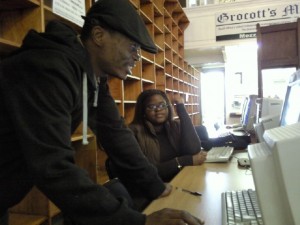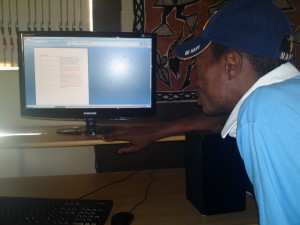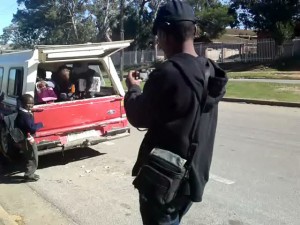Despite our anxieties, however, luck was on our side. Thembeni was praised by the Chief editor of Grocotts, Kwanele Bhutane as being one of the best citizen journalists Grocotts had, having published several stories on the Grocotts mail website over the last few months. This would be an advantage when it came to finding stories to film because it meant he already had a sense of what was newsworthy and what was not. When we finally did meet, we shared brief hellos and got right down to work. Tamsin and I explained to Thembeni the fundamental aspects of filming stories such as the difference between finding stories for print and finding stories for television. We explained the meaning of terms such as ‘visually compelling’, ‘six second shot rule’ and lighting. His countenance at this point had shifted from jovial to worried (a look we would come to see plenty of over the next few weeks!) and Tamsin and I attempt to calm him repeating that it was not as hard as it sounded to film stories once you ‘got the hang of it’.
For that first week we assigned Thembeni to film a ten second clip of news stories he was already working on for Grocotts as a print stories. The first story was that of the illegal transportation of school children in vans which was deemed unsafe by the South African Government. The second story was covering the march that had been organised by Mary Waters high school students outside the Magistrates court, to protest the bail applications of two men, who allegedly raped a female student from their high school. The clips Thembeni filmed were very good for first attempts at filming and even included a skill we had not taught him, panning! After congratulating him on his work, we wasted no time in planning for the next assignment, a one minute piece which would undoubtedly require more effort on both mine and Tamsin’s side, as well as that of Thembeni.
We agreed that a continuation of the Mary Waters story he would be telling with one of the ten second clips would be ideal and were exhilarated to learn that Thembeni had heard rumours of community members wishing to demolish the abandoned house where the rape occurred. By removing the scene where the horrific incident occurred, the community wanted to show their intolerance for such crimes and prevent a repeat of the same crime befalling another student (since the area around the house was surrounded by schools). In high pitched voices laden with excitement Tamsin and I explained the potential behind capturing bulldozers ripping down walls with community members tearing up, watching on the sidelines. Filming stories had certainly made an impression on what counted as excitement in our lives! Unfortunately when the day came for us to accompany Thembeni to shoot the story, we were disappointed to find that the demolition team consisted of two men who were taking apart the roof and probably would not get around to tearing down the walls until at least 2 weeks later. We did however make the most of it and shot as much footage of pounding hammers as possible instructing Thembeni afterwards on how to shoot sequences. Once again, those familiar worry lines appeared on his face and once again Tamsin told him not to worry!
When Thembeni was free one afternoon we invited him up to the journalism department where we showed him what we meant by sequences by making him watch our how to videos. At that point he understood what we had trying to explain to him and managed to film at least 3 sequential shots for the final story. Up until this point we had suffered no horrendous hiccups, but a large one loomed over us like a dark cloud and would release its might as soon as we would start editing!
Formats formats formats! The one downside of working with cellphone footage is having to change various formats into other formats before using editing software designed for ‘proper cameras’. Despite the problems it gave us, Tamsin and I stuck with Windows Movie maker as we felt it would benefit Thembeni to learn how to edit on it, since he could access it through the Grocotts computers. After converting his footage from QuickTime., to wmv. we started the editing process and quickly learned that Windows Movie Maker was not necessarily as difficult to use as Adobe Premier Pro, (the software we were taught how to use in first term) it was just twice as slow and gave us twice as many problems, freezing constantly. Eventually we did finish editing it, with narration. Thembeni, having worked as a newsreader at Rhodes Music Radio required little guidance apart from pace instruction, when recording his narration.
When reflecting on the whole experience of working with a citizen journalist Tamsin and I agreed that while it was much easier to work with a television crew that knew just as much as you did, it was good feeling to know that you helped teach someone something they otherwise might have never known. The live television show was a pleasant way of marking the end of our working relationships with Thembeni, after all that hard work he was able see what it was all for.
View Thembeni Plaatjie’s story map in a larger map 




Add A Comment